The Survival Foods You Can Only Harvest This Spring
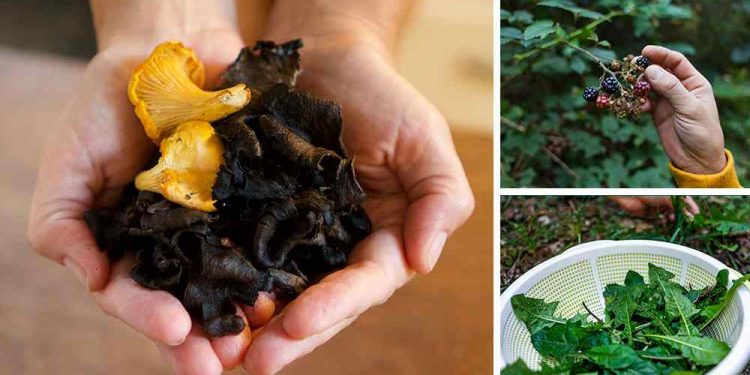 by APRIL K.
by APRIL K.
Which wild survival plants can you harvest this spring? You will find edible and medicinal plants, so forage for food when it starts getting warmer and the new growth period commences.
There are plenty of edible mushrooms, fresh salad greens, shoots, and flavorsome flowers to be found.
You may want to invest in a guidebook to make sure you know how to identify edible plants as some may be poisonous to humans. Never eat a plant of which you are not sure.
Dandelions
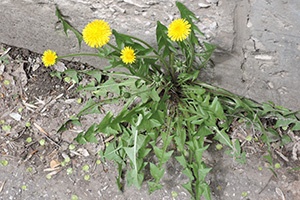 Dandelions are edible and have medicinal properties. Use the roots to make coffee, the leaves to make pesto, and produce salve with the flowers.
Dandelions are edible and have medicinal properties. Use the roots to make coffee, the leaves to make pesto, and produce salve with the flowers.
Use the herb’s leaves and yellow flower petals in a salad or cook and eat the leaves as you would spinach.
You may need a trowel to remove the roots from the soil intact to make dandelion root coffee in early spring. They shrink and become bitter when the plant starts flowering.
You will need about 15 – minus the thin, spindly parts you can use for a tincture – to make enough for one cup of coffee.
tincture – to make enough for one cup of coffee.
Wash them carefully and chop them off and save the upper leaves to create a delicious salad. Roast the root for 40 minutes at 350 degrees.
Once dry and roasted, mix the roots with cardamom, fennel, or cinnamon – if you have any at hand – and simmer the mixture for ten to 15 minutes. Strain it through a thin mesh and enjoy!
Chickweed
Chickweed is a pleasant green. You can eat the flower, bud, leaf, and the tender one or two inches of the top of the stem.
People see it as a weed in North America, but alternative medicine practitioners and herbalists view it as nutritious food and a folk remedy with health benefits.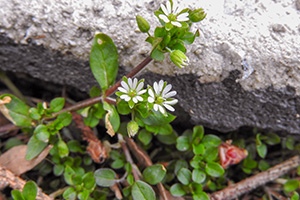
Chickweed contains more minerals and vitamins per ounce than kale or spinach.
It grows to just a few inches above the ground, has small leaves with pointed tips that are teardrop to egg-shaped, and grow opposite each other on the stem. Fine hairs cover the tiny flowers – that consist of five white petals with deep crevices – and the leaves around their base.
A single line of ‘hairs’ runs along the stem’s length, distinguishing it from its poisonous lookalike, scarlet pimpernel.
Chickweed has several medicinal uses. Treat itchy insect bites and alleviate inflammatory skin conditions, rashes, eczema, and psoriasis topically. You can ingest chickweed leaves to fight bowel and stomach disorders like constipation, asthma, and other lung problems.
Use it to treat scurvy (vitamin C deficiency), blood disorders, obesity, muscle, and joint pain.
Now that you know that it can assist you in so many ways, you may re-consider killing all the chickweed in your lawn and garden.
Cattails
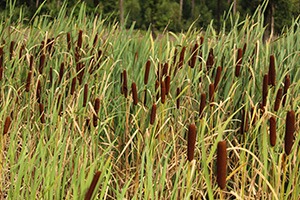 Cattail shoots are seen by many as the definitive survival plant. Every part of this bulrush-type plant has a use.
Cattail shoots are seen by many as the definitive survival plant. Every part of this bulrush-type plant has a use.
Cattails are aggressive growers that behave like an introduced weed, but they are an indigenous element in many natural communities and are beneficial as wildlife habitat.
You can eat the cat’s tails and the young shoots – that resemble leeks and taste like cucumber – raw or sautéed. The first four to ten inches are tender.
Use the yellow pollen that coats the top male flower cluster as a substitute for flour in pastries and bread. Shake the pollen into a bag and use a kitchen strainer to remove the insects and woolly material.
Place it on a flat plate at a low oven temperature – with the door open an inch or two – for about two hours to dehydrate, or it may mold and go bad.
Boil the male flower for ten to 15 minutes or sauté it. Eat the bottom female cluster like corn on the cob while it is still young and green. Simmer it for 15 to 20 minutes and add salt, pepper, and butter for a delicious meal.
The plant grows in swampy and desert areas. Make sure that you only pick plants that have cigar-shaped heads. Don’t eat a similar-looking plant that doesn’t have them. You may be ingesting the iris, which is poisonous.
Berries
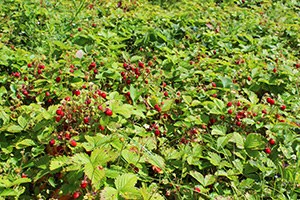 Harvest blueberries from late May or once they’ve turned grey-blue all around and fall into your hand without needing to be pulled or tugged.
Harvest blueberries from late May or once they’ve turned grey-blue all around and fall into your hand without needing to be pulled or tugged.
The best time to harvest blackberries in the south is spring or early summer – when they’ve turned from red to black – whereas the peak season is during July and August in the rest of the country.
Wild strawberries are common native plants. They are edible, sweet-tasting, juicy, and found in yards, woodlands, and open fields. They are warm-weather plants that ripen when the weather suits them – from early May to late October – depending on the temperature.
Wild strawberrie turn red when ripe, are smaller and seedier than cultivated strawberries, and smell sweet. You can eat other parts of the plant and make a tea of the vitamin C-rich leaves.
Eat berries fresh on cereals, in pancakes, or fruit salad shortly after harvesting, or freeze them. You can also turn them into sauces, jellies, jams, and preserves.
Mushrooms
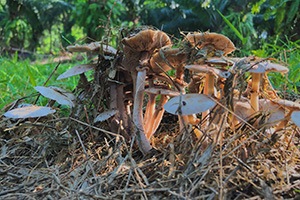 Forage for morel mushrooms. Their caps are egg-shaped, bulbous, cone-shaped, or oblong and attached to short, chubby stems. They can be small or large. Cook before eating them; they taste lovely when deep-fried or sautéed. Morel mushrooms are tender and meaty with a woodsy, earthy, nutty flavor.
Forage for morel mushrooms. Their caps are egg-shaped, bulbous, cone-shaped, or oblong and attached to short, chubby stems. They can be small or large. Cook before eating them; they taste lovely when deep-fried or sautéed. Morel mushrooms are tender and meaty with a woodsy, earthy, nutty flavor.
Oyster mushrooms grow in many areas through spring into fall. They originate on tree stumps and fallen logs and have a gentle, aromatic flavor and delicate texture. They are fan or oyster shaped with thin, broad, tan, grey, or white caps with gills along the underside.
King Bolete or porcini mushrooms grow in decomposing organic material under conifer trees and come out in spring or after rainfall in late summer or fall. The yellow-brown to reddish-brown cap resembles a somewhat greasy bun.
They can grow up to 12 inches and weigh two pounds when mature. The solid white stem shows a faint webbed or net pattern, and the flesh should stay white when you cut it. The earthy, nutty, meaty flavor is tasty in broths or sauces.
This recipe will work for almost any type of mushroom. Cut the mushrooms into pieces of equal sizes for even cooking. Heat two tablespoons of olive oil in a heavy, large pan at medium-high temperature.
Spread the mushrooms out evenly and leave them to cook for three to five minutes until they start to brown. Toss them and cook for the same amount of time until they are brown. Mix in a few thyme sprigs, garlic cloves, and two tablespoons of ghee or butter.
Cook another five minutes on medium-low while spooning the butter over the mushrooms. Cook until dark and just about crispy and season to taste with salt and pepper.
What Other Options Are There?
Related: The Forager’s Guide To Wild Foods
Spring nettles consist of 25 percent protein and are high in vitamins A and C, calcium, manganese, potassium, and iron. Harvest the stem and top four leaves in March or April if you have a pair of rubber gloves, a bucket, and kitchen scissors. You can still eat the leaves later, but only until they start to bloom. Sego lily bulbs and bark bread are also famine foods.
Gather bright green, tender white spruce buds and needles to make tea for colds and flu and grind the bark to make flour.
Boil or roast green maple seeds – the smaller, the sweeter. Remove the outer skin, simmer them until soft – about 15 minutes – or place them on a baking sheet for eight to ten minutes at 350 degrees. Add butter, salt, pepper, or the seasoning of your choice.
We’ve mentioned a few of the tastier possibilities and wish you happy spring eating from the wild forests, roadsides, open fields, and your backyard.
This is one book you probably won’t want to have missing from your bug out bag and survival stash, as this is a golden ticket to food independence, especially when you are on the go.
Despite all the features that have been put together masterfully in this one book, I must say that there is something that I wish was done differently.
When foraging in the wild I find it easier to use a smaller book that is easy to carry.
Sadly, this book is not pocket sized and it doesn’t have detachable pages. It’s big and it is heavy, it’s not easy to take on a hike, but at the same time it would have been impossible to have good large pictures with plants and so many details in a pocket size book.
Overall The Forager’s Guide to Wild Foods is a valuable find. I expected a thorough guide, but I was pleasantly surprised by the wealth of lost knowledge uncovered in this book. I feel that this is great value for money and there are so many things to learn from this book.
If you haven’t already got your copy of this book, go ahead and:
Click Here to Get Your Copy of The Forager’s Guide to Wild Foods!
Anyone can join.
Anyone can contribute.
Anyone can become informed about their world.
"United We Stand" Click Here To Create Your Personal Citizen Journalist Account Today, Be Sure To Invite Your Friends.
Please Help Support BeforeitsNews by trying our Natural Health Products below!
Order by Phone at 888-809-8385 or online at https://mitocopper.com M - F 9am to 5pm EST
Order by Phone at 866-388-7003 or online at https://www.herbanomic.com M - F 9am to 5pm EST
Order by Phone at 866-388-7003 or online at https://www.herbanomics.com M - F 9am to 5pm EST
Humic & Fulvic Trace Minerals Complex - Nature's most important supplement! Vivid Dreams again!
HNEX HydroNano EXtracellular Water - Improve immune system health and reduce inflammation.
Ultimate Clinical Potency Curcumin - Natural pain relief, reduce inflammation and so much more.
MitoCopper - Bioavailable Copper destroys pathogens and gives you more energy. (See Blood Video)
Oxy Powder - Natural Colon Cleanser! Cleans out toxic buildup with oxygen!
Nascent Iodine - Promotes detoxification, mental focus and thyroid health.
Smart Meter Cover - Reduces Smart Meter radiation by 96%! (See Video).






